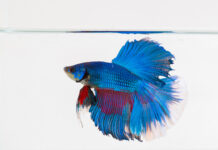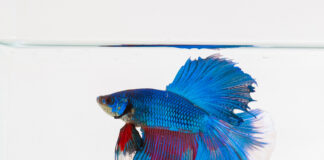Feeding fish regularly often becomes a perfunctory routine where we donât fixate as much on the fish food or flakes we give our marine pets. Additionally, due to the mass commercialization of fish food, we hardly wonder about alternatives to the type of meals we feed the aqua critters.
Beyond survival, the right food and diet are vital to a fishâs health, energy, as well as the following (and much-coveted) bright and intense colors prevalent on healthy fish.
Granted, commercial fish food may already contain the basic nutrients for healthy fish.
So, as long as youâre getting high-quality fish flakes from reputable sources then, âwhy should you make your fish food at home if you can just buy it?â This article addresses just that as well as how to make fish food in the comfort of your home.
More…
Feeding with the Fishes

Like us, fish can also be discriminating diners. Although youâll never hear them complain, quite literally, your fish would enjoy the variety of food beyond the commercial fish flake.
Naturally, fish feed manufacturers canât cater to the diets of every fish species, health, and, stage of development. Even if they did, the subsequent specialized fish feed would be prohibitively expensive. Fortunately, homemade fish food addresses these concerns.
Benefits of Homemade Fish Food
Budget-friendly & Nutrition Control

Yes, there are cheap fish food options, but aquaculturists and serious hobbyists donât typically recommend these arguably inferior products.
Then again, adequately priced fish food will only give you the basic nutrition that acts as a blanket diet to many fish species that may have specific dietary needs.
Finally, the fact that commercial fish food that is specialized can be very expensive adds to the benefit of homemade fish food being affordable with the benefit of being able to control what goes into your fish food.
Healthier Fish
Naturally, a superior and specialized diet will result in healthier and more active fish since you will be able to address their specific dietary needs. In addition to addressing the fish feed of a particular species, youâll also be able to make necessary changes in their diet during different stages of growth.
Color enhancement

Another benefit to homemade fish food that typically goes hand in hand with improved health is the strengthening of a fishâs skin color.
In the wild, the color intensity of a fishâs skin is mainly due to its diverse diet. This diet usually contains natural pigments from aquatic plants and marine life.
Although artificial colors are present in commercial fish food, they simply cannot compare with natural pigments, such as carotenoids, found in natural food sources.
The Guidelines in Making Fish Food at Home
Like the numerous species of fish, there is no single method or recipe for homemade fish food. However, in your quest to play personal chef with your aquarium pets, itâs best to consider several guidelines.
Research Your Fishâs Natural Diet

So youâll have a good grasp of the type of diet that you need to provide your fish, you can do a bit of research about the food they would naturally feed on in the wild. Research may include a quick search on the internet, inquiring of your local pet shop owner, or an experienced aquaculturist with similar fish as yours.
Also, remember to look into their nutritional needs as well as their food preference.
Fish Type
In a similar way to land animals, dietary requirements categorize fish into omnivores, carnivores, and herbivores. Hence, knowing which category your fish falls into will guide you into the composition of the fish food youâll be making.
In protein requirements, for instance, tilapia and herbivorous fish require 28% to 35% protein in their diets. Meanwhile, omnivores and carnivores need 30% to 40% and 38% to 45% protein, respectively. Also, juvenile fish may need more during their growth.
Specific Dietary Sources

Once you have a good understanding of your fishesâ kind and natural diet, you may proceed in choosing the composition of your homemade fish food.
Animal / Protein Sources
When picking the animal or protein sources for your homemade fish food, try to get the free range or organic options if possible. These natural sources will improve their nutritional value as ingredients.
Some examples of animal ingredients are earthworms, brine shrimp, mosquito larvae, beef heart as well as other fish.
Whichever of these protein sources you end up choosing, make sure to purchase from reliable sources to minimize contamination and disease.
Remember though, that you should cook raw seafood to the extent that there is minimal bacterial contamination. This requirement is also necessary for eggs if you plan to add this to your fish food.
Plant Sources

Again, when sourcing plant-based ingredients, try to get organically-grown options as conventional veggies and plants may contain pesticide and herbicide residue.
Good plant sources include dark leafy vegetable, broccoli, zucchini, carrots, apples, and pears. Additionally, mixing garlic in your homemade fish food will make it very appetizing as well as nutritious.
Vitamins
Fish will benefit from vitamin supplementation especially vitamin C since, like us, many fish cannot process their own. Again, refer to your fish store or experience aquaculturist about great aquarium food supplements.
Binding Agents
Your homemade fish food will need a form of the binding agent for everything to mix well and homogenize for it to work properly especially in water. These binding agents include, for instance, starchy ingredients such as potatoes, corn starch and the like.
Procedure

When youâve gathered the ingredients that will make up your homemade fish feed, hereâs the guide to making into a form that your fish will love.
- Prepare and Clean your ingredients
- Use a blender or food process to mix your ingredients into an even consistency thoroughly.
- âEnsure that you strain the resulting mix through a medium-fine mesh. This process provides you filter any large pieces of food that be difficult for your fish to eat.
- âThoroughly dry the strained mixture in an oven over very low heat for about 3 to 4 hours.
- âCrumble and break apart the dry mixture into chunks and then flakes appropriate for your fish.
- Store your homemade fish food in a fresh and dark space.
Conclusion

Feeding your fish with homemade fish food filled not only with high-quality ingredients but also your time and love will bring joy to you as well as to your aquarium pets.
Just remember to follow these guidelines on how to make fish food for the healthiest of marine life.
Lastly, if youâre looking for specific recipe ideas, here are some that weâd suggest: homemade fish pellets and a nutrition bomb of fish feed.







